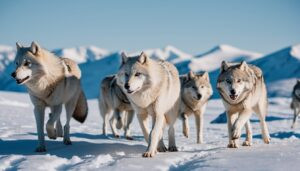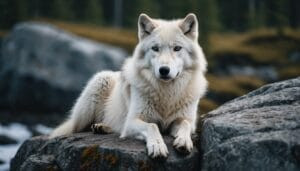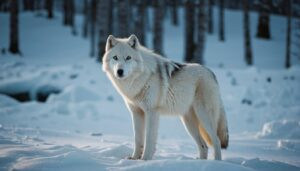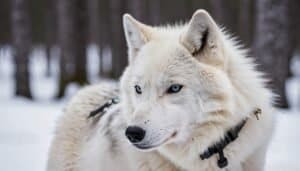Introduction
Research activities in Arctic regions are vital for understanding the dynamics of Arctic wolf populations
This article delves into various aspects of how research impacts these majestic creatures. We’ll explore the main research activities conducted in their habitats, the immediate and long-term effects of human presence, and the methods used in such studies
Additionally, we’ll examine how conservation efforts are supported by research, the ethical considerations involved, and the influence of climate change on research activities. Through this comprehensive overview, we aim to shed light on the intricate relationship between research and Arctic wolf populations
Main Research Activities in Arctic Wolf Habitats
Research in Arctic wolf habitats is crucial for understanding their behavior, ecology, and conservation needs. These activities often involve various methodologies and focus areas that provide valuable insights into the lives of these elusive animals
Types of Research Conducted
Research on Arctic wolves typically includes behavioral studies, population surveys, and ecological monitoring. Behavioral studies aim to understand the daily activities, social structures, and interactions of Arctic wolves within their packs
These studies often involve direct observation, camera traps, and tracking devices. For example, researchers may observe how wolves hunt, interact with each other, and raise their young
Population surveys are another common type of research. These surveys help estimate the number of wolves in a given area, track changes over time, and assess the health and genetic diversity of the populations. Methods used in population surveys include aerial surveys, ground tracking, and the collection of genetic samples from scat or hair
Ecological monitoring focuses on understanding the wolves’ roles within their ecosystems. This includes studying their prey, such as caribou and Arctic hares, and examining how changes in the environment affect wolf populations
Researchers might look at the availability of prey, the impact of climate change on the ecosystem, and the wolves’ interactions with other predators
Geographic Focus of Research
Arctic wolf research is primarily conducted in remote and harsh environments across the Arctic region. Key research areas include parts of Canada, Alaska, and Greenland. Each of these locations presents unique challenges and opportunities for researchers
In Canada, for instance, the vast tundra and boreal forest regions provide a diverse range of habitats for Arctic wolves. Researchers in this area may focus on how wolves adapt to different environmental conditions and how they coexist with other wildlife
Alaska offers another critical research area, where scientists study the interactions between wolves and other large predators like bears. The state’s rugged terrain and extreme weather conditions make it an ideal place to observe how Arctic wolves cope with and adapt to such challenges
Greenland, with its icy landscapes and limited human presence, provides a pristine environment for studying Arctic wolves in one of the most extreme climates on Earth. Research in Greenland often focuses on the impact of melting ice and changing weather patterns on wolf populations and their prey
Research Objectives and Goals
The primary objectives of Arctic wolf research are to understand their behavior, monitor population dynamics, and develop conservation strategies
By studying their behavior, scientists can gain insights into how wolves communicate, hunt, and raise their young. This knowledge is essential for developing effective management and conservation plans
Monitoring population dynamics involves tracking changes in wolf numbers, health, and genetic diversity over time. This helps researchers identify trends and potential threats to the population, such as disease outbreaks or habitat loss. For example, a study published in the journal “Ecology” in 2019 highlighted the importance of long-term monitoring to detect population declines linked to climate change
Conservation strategies derived from research are crucial for protecting Arctic wolves and their habitats. These strategies may include creating protected areas, implementing policies to reduce human-wildlife conflict, and conducting public education campaigns to raise awareness about the importance of Arctic wolves in their ecosystems
Research also aims to understand the broader ecological impacts of Arctic wolves
By studying their interactions with prey and other predators, scientists can gain a better understanding of the complex food webs and ecosystem dynamics in the Arctic. This information is vital for predicting how changes in the environment, such as global warming, might affect the entire ecosystem
Impacts of Research Activities on Arctic Wolves
Research activities, while crucial for understanding Arctic wolves, can also have significant impacts on these animals. The effects can be immediate or long-term, influencing various aspects of their lives, from behavior to population dynamics
Immediate Behavioral Changes
The presence of researchers in Arctic wolf habitats can lead to immediate changes in wolf behavior. These changes often occur because wolves are highly perceptive animals that can detect human presence from a distance
For instance, wolves may become more cautious and alter their movement patterns to avoid areas frequented by researchers. This behavior was observed in a study published in the “Journal of Wildlife Management” in 2020, which found that Arctic wolves tended to avoid areas where human activity was high
Additionally, the introduction of research equipment, such as camera traps and tracking devices, can cause temporary disturbances. Wolves may initially react to these unfamiliar objects with curiosity or wariness. However, most studies have shown that wolves often acclimate to these devices over time, returning to their normal activities once they perceive no immediate threat
Long-term Population Effects
Long-term effects of research activities can vary depending on the nature and intensity of the research
Continuous human presence and frequent disturbances can potentially lead to changes in habitat use, affecting the wolves’ access to resources such as prey and denning sites. For example, if wolves start avoiding certain areas due to human activity, they might have to travel further to find food, which can impact their overall health and reproductive success
A comprehensive study conducted over a decade and published in “Biological Conservation” in 2017 highlighted that persistent research activities could lead to altered pack structures and dynamics. In some cases, high levels of disturbance were associated with decreased pup survival rates, likely due to increased stress and disruption of normal rearing behaviors
Impact on Reproductive Success
Research activities can directly affect the reproductive success of Arctic wolves
Disturbances during critical periods, such as mating season or when females are nursing pups, can lead to lower reproductive rates. Noise and human presence can cause pregnant females to abandon their dens or move to less suitable habitats, negatively impacting pup survival
For instance, a study published in the “Canadian Journal of Zoology” in 2015 found that Arctic wolves exposed to frequent disturbances had significantly lower reproductive success compared to those in undisturbed areas
The study emphasized the importance of minimizing human activity during sensitive periods to ensure healthy reproduction and pup development
Stress Responses in Arctic Wolves
Exposure to human activities and research interventions can induce stress responses in Arctic wolves
Stress can manifest through various physiological and behavioral changes, including increased cortisol levels, altered feeding habits, and changes in social interactions within the pack. Elevated stress levels can have detrimental effects on the wolves’ immune systems, making them more susceptible to diseases
Research published in the “Journal of Animal Ecology” in 2018 highlighted that Arctic wolves exposed to high levels of human activity showed increased stress markers compared to those in more isolated areas. This study underscored the need for researchers to adopt practices that minimize stress, such as maintaining a safe distance and using non-invasive monitoring techniques
Adaptation Mechanisms
Despite the potential negative impacts, Arctic wolves have shown remarkable adaptability to human presence and research activities. Over time, wolves can become habituated to non-threatening human activities, reducing their stress responses and allowing them to continue their normal behaviors
For instance, in areas where research activities are conducted regularly but with minimal disturbance, wolves have been observed to carry on with their hunting and social activities largely unaffected
A study published in “Ethology” in 2016 documented how Arctic wolves in a research-intensive area gradually adapted to the presence of researchers, exhibiting fewer avoidance behaviors and maintaining stable pack dynamics
This adaptability suggests that, with careful management and ethical research practices, the long-term impacts on Arctic wolves can be mitigated
Research Methods and Technological Influence
Research on Arctic wolves involves various methods and technological advancements to study their behavior, population dynamics, and ecological interactions. These methods aim to gather detailed and accurate data while minimizing disturbances to the wolves
Tracking Devices and Collars
One of the primary tools used in Arctic wolf research is tracking devices, such as GPS collars
These devices allow researchers to monitor the movements, territory ranges, and hunting patterns of individual wolves with high precision. GPS collars provide real-time data on the wolves’ locations, helping researchers understand their spatial behavior and habitat use
For instance, a study published in “Animal Biotelemetry” in 2018 demonstrated how GPS collars were used to track Arctic wolves in Canada’s tundra. The study revealed insights into the wolves’ extensive travel ranges, seasonal migration patterns, and preferred hunting grounds. The data collected from these collars helped identify critical habitats that are essential for the wolves’ survival and can guide conservation efforts
However, fitting wolves with collars requires capturing and handling the animals, which can cause stress and temporary behavioral changes
Researchers must ensure that the process is conducted ethically and with minimal harm to the wolves. Advances in technology have led to the development of lighter and more efficient collars that reduce the impact on the animals and improve data accuracy
Remote Monitoring Techniques
In addition to tracking devices, remote monitoring techniques, such as camera traps and drones, are widely used in Arctic wolf research
Camera traps are motion-activated cameras placed in strategic locations to capture images and videos of wolves in their natural habitats. These cameras provide valuable information on the wolves’ behavior, social interactions, and prey preferences without direct human intervention
A study published in “Ecological Applications” in 2019 utilized camera traps to study Arctic wolves in Greenland. The researchers were able to document the wolves’ hunting strategies, pack hierarchy, and interactions with other wildlife. Camera traps offer a non-invasive way to collect data over extended periods, even in harsh and remote environments
Drones are another innovative tool that has gained popularity in wildlife research. Equipped with high-resolution cameras, drones can cover large areas and provide aerial views of the wolves’ habitats. They are particularly useful for monitoring inaccessible or dangerous terrains, such as ice fields and dense forests
A 2020 study in “Remote Sensing in Ecology and Conservation” highlighted how drones were used to monitor Arctic wolf populations in Alaska, offering a comprehensive overview of their distribution and habitat use
Data Collection and Analysis
The vast amount of data collected through tracking devices, camera traps, and drones requires meticulous analysis to draw meaningful conclusions
Researchers use various statistical and computational techniques to analyze movement patterns, habitat preferences, and ecological interactions. Geographic Information Systems (GIS) are often employed to map the spatial data and identify critical habitats and migration corridors
For example, a study published in “Ecology and Evolution” in 2017 used GIS to analyze GPS data from collared Arctic wolves. The analysis revealed important insights into how environmental factors, such as snow cover and prey availability, influence the wolves’ movements and habitat selection
This information is crucial for developing effective conservation strategies and managing human-wildlife conflicts
Advanced software tools and machine learning algorithms are also used to process and interpret large datasets. These tools can identify patterns and trends that may not be apparent through traditional analysis methods. For instance, machine learning models can predict the wolves’ responses to environmental changes and human activities, providing valuable information for conservation planning
Conservation Efforts Supported by Research
Research activities are integral to developing effective conservation strategies for Arctic wolves. The data and insights gained from these studies help inform policies, habitat protection initiatives, and community involvement efforts aimed at preserving Arctic wolf populations and their ecosystems
Habitat Protection Initiatives
One of the primary conservation efforts supported by research is the identification and protection of critical habitats
Research provides detailed information about the areas that are essential for the wolves’ survival, such as breeding sites, denning areas, and key hunting grounds. Protecting these habitats ensures that Arctic wolves have the space and resources they need to thrive
For instance, a study published in “Conservation Biology” in 2020 highlighted the importance of preserving tundra regions in Canada where Arctic wolves are known to raise their pups. The study’s findings led to the establishment of protected areas where human activities are restricted, helping to maintain the integrity of these critical habitats
Additionally, research helps identify corridors that connect different wolf populations, facilitating gene flow and reducing the risks of inbreeding
This is particularly important in the face of habitat fragmentation caused by human activities and climate change. Conservation efforts often focus on creating or maintaining these corridors to ensure healthy and genetically diverse wolf populations
Policy Development and Implementation
Research findings play a crucial role in shaping wildlife policies and management practices. Policymakers rely on scientific data to make informed decisions about wildlife protection, hunting regulations, and land use planning. By providing evidence-based recommendations, researchers can influence policies that benefit Arctic wolves and their habitats
For example, research conducted by wildlife biologists in Alaska, published in “Global Ecology and Conservation” in 2019, led to stricter regulations on industrial activities in areas crucial for Arctic wolf populations. The study demonstrated how oil and gas exploration negatively impacted wolf habitats, prompting policymakers to enforce measures that mitigate these effects
Research also informs international conservation agreements and collaborations. The Arctic region spans multiple countries, and effective conservation requires cooperation among these nations
Studies on Arctic wolves contribute to a better understanding of transboundary populations and the need for coordinated conservation efforts. For instance, the Arctic Council, which includes countries like the United States, Canada, and Russia, uses research data to develop joint conservation strategies for Arctic wildlife
Community Involvement in Conservation
Community involvement is essential for successful conservation efforts. Engaging local communities in research and conservation activities helps build support for protecting Arctic wolves and their habitats. Research projects often include educational components that raise awareness about the importance of Arctic wolves and the threats they face
Local communities can also contribute valuable knowledge and observations that enhance research efforts
For example, Indigenous knowledge about wolf behavior and ecology can complement scientific studies, providing a more comprehensive understanding of these animals. Collaborative research projects that involve local communities can lead to more effective and culturally sensitive conservation strategies
A study published in “Ecological Restoration” in 2021 highlighted a successful community-based conservation project in Greenland. Researchers worked closely with local communities to monitor Arctic wolf populations and implement conservation measures. This collaboration resulted in increased awareness and support for wolf conservation, as well as the establishment of community-managed protected areas
Ethical Considerations in Arctic Wolf Research
Conducting research on Arctic wolves involves various ethical considerations to ensure the welfare of the animals and the integrity of the ecosystem. Ethical research practices are essential to minimize harm, reduce stress, and uphold the highest standards of animal care and conservation
Minimizing Disturbance
One of the primary ethical considerations in Arctic wolf research is minimizing disturbance to the animals and their habitat
Researchers must carefully plan their activities to avoid disrupting the wolves’ natural behaviors and daily routines. This involves choosing non-invasive methods whenever possible and ensuring that any necessary interventions are conducted with minimal impact
For example, when deploying tracking collars, researchers must use methods that minimize the time the wolves spend under anesthesia and ensure the collars are lightweight and do not interfere with the wolves’ movements
A study published in “Methods in Ecology and Evolution” in 2018 emphasized the importance of using the least intrusive methods for tagging and monitoring wildlife, recommending advances in collar design to reduce stress and improve animal welfare
Additionally, researchers often schedule their fieldwork to avoid sensitive periods such as breeding and denning seasons. By timing their activities to coincide with less critical times in the wolves’ life cycles, researchers can minimize potential disturbances. For instance, a study in “Wildlife Society Bulletin” in 2019 highlighted the importance of avoiding den sites during the pupping season to prevent stress and abandonment
Welfare of Captured Animals
The welfare of captured Arctic wolves is a critical ethical concern. When wolves are captured for tagging or other research purposes, it is essential to ensure that the process is as humane and stress-free as possible. This includes using the safest and most effective capture techniques, providing adequate care during handling, and ensuring a quick recovery after release
Researchers must be trained in proper handling techniques and the use of anesthesia to minimize risks to the wolves
Post-capture monitoring is also crucial to ensure the animals do not suffer from long-term effects of the capture. A 2017 study in “Journal of Mammalogy” outlined best practices for capturing and handling large carnivores, emphasizing the need for thorough training and adherence to ethical guidelines to safeguard animal welfare
Moreover, ethical guidelines require that researchers have contingency plans in place for any unforeseen events, such as injuries or adverse reactions to anesthesia. Ensuring that veterinary care is available and that animals can be treated promptly is a fundamental aspect of ethical wildlife research
Ethical Guidelines and Regulations
Ethical research on Arctic wolves is governed by strict guidelines and regulations to ensure responsible and humane treatment of the animals
These guidelines are often established by institutional review boards, wildlife management agencies, and professional organizations. Adhering to these standards is mandatory for conducting ethical and scientifically valid research
In the United States, researchers must comply with regulations set forth by the Institutional Animal Care and Use Committee (IACUC), which oversees the ethical treatment of animals in research. Similar guidelines are in place in Canada, governed by the Canadian Council on Animal Care (CCAC)
These bodies require researchers to justify the necessity of their studies, use the minimum number of animals needed, and apply the least invasive methods available
Internationally, ethical wildlife research is supported by guidelines from organizations such as the International Union for Conservation of Nature (IUCN) and the Wildlife Society. These guidelines emphasize the principles of reduction, refinement, and replacement (the 3Rs) to minimize the impact on wildlife
For example, a report from the IUCN in 2020 highlighted the importance of using non-invasive techniques and ensuring that any invasive procedures are scientifically justified and conducted with the utmost care
Climate Change and Its Role in Research
Climate change has a profound impact on the Arctic environment and, consequently, on Arctic wolf populations. Understanding these impacts is crucial for conducting relevant and effective research that can guide conservation efforts in a rapidly changing world
Changing Arctic Ecosystem
The Arctic ecosystem is undergoing significant changes due to climate change, including rising temperatures, melting sea ice, and altered weather patterns. These changes affect the availability of prey, the structure of habitats, and the overall dynamics of the ecosystem in which Arctic wolves live
Research conducted by the National Snow and Ice Data Center (NSIDC) in 2021 indicates that the Arctic is warming at more than twice the global average rate, a phenomenon known as Arctic amplification. This rapid warming is leading to the loss of sea ice and permafrost, which in turn affects the distribution and abundance of species that Arctic wolves rely on for food
Studies have shown that these environmental changes are forcing Arctic wolves to adapt to new conditions
For instance, a 2019 study in “Global Change Biology” documented shifts in the wolves’ hunting patterns and diet composition in response to declining populations of traditional prey like caribou and muskox. Researchers found that wolves are increasingly preying on smaller mammals and birds, which could have cascading effects on the broader ecosystem
Impact on Prey Availability
The availability of prey is a critical factor for the survival and reproductive success of Arctic wolves
Climate change-induced alterations in prey populations can directly affect wolf populations. For example, the declining sea ice is impacting the distribution of seals, a primary food source for many Arctic predators, which in turn affects the prey available for wolves
A study published in “Ecology Letters” in 2018 highlighted how the diminishing sea ice is causing shifts in the spatial distribution of prey species
This study found that the reduced ice cover is leading to decreased populations of Arctic hares and lemmings, important prey for Arctic wolves, forcing them to travel greater distances to find food. This increased effort can affect their energy balance, health, and reproductive success
Furthermore, climate change is altering the timing of seasonal events, such as the migration patterns of caribou. Research published in “Nature Climate Change” in 2020 showed that mismatched timing between caribou migrations and the peak availability of vegetation can lead to nutritional stress in caribou, reducing their numbers and making it harder for Arctic wolves to find sufficient prey
Adaptation of Research Methods
Climate change necessitates adaptations in research methods to accurately study and monitor Arctic wolf populations. Traditional research methods may become less effective as environmental conditions change, requiring researchers to innovate and employ new techniques
Remote sensing technology, such as satellite imagery and drone surveillance, is increasingly used to monitor the changing Arctic landscape and track wolf movements in response to these changes
For example, a 2021 study in “Remote Sensing in Ecology and Conservation” utilized high-resolution satellite imagery to map changes in Arctic habitats and assess the impact on wolf territories. This approach allows researchers to cover large, inaccessible areas and gather data on habitat changes and wolf distribution
Additionally, climate models are becoming essential tools for predicting future changes in the Arctic environment and their potential impacts on wolf populations. These models can simulate different climate scenarios and help researchers understand how various factors, such as temperature increases and precipitation changes, might affect Arctic wolves
A study in “Ecological Modelling” in 2019 used such models to predict shifts in Arctic wolf habitats over the next few decades, providing valuable insights for long-term conservation planning
The use of genetic and physiological studies is also expanding to understand how Arctic wolves are adapting to changing environmental conditions. Researchers are examining genetic markers associated with stress responses and adaptation to new diets, as well as physiological changes such as alterations in body fat composition and reproductive cycles
Conclusion
The presence of research activities in Arctic wolf habitats is both crucial and complex, affecting various aspects of these animals’ lives. Research provides invaluable insights into wolf behavior, population dynamics, and ecological interactions, which are essential for effective conservation strategies
However, these activities must be conducted ethically and with minimal disturbance to ensure the well-being of the wolves and the integrity of their habitats
Research methods have evolved significantly, with tracking devices, remote monitoring techniques, and advanced data analysis tools enhancing our ability to study Arctic wolves with precision and minimal impact. These technologies help gather detailed data on movement patterns, habitat use, and ecological interactions, guiding conservation efforts
Climate change adds another layer of complexity, profoundly impacting the Arctic ecosystem and the availability of prey for Arctic wolves. Research is critical in understanding these changes and developing adaptive strategies to protect wolf populations
Ethical considerations are paramount in all research activities, ensuring that the welfare of the wolves is prioritized and that guidelines and regulations are strictly followed. Through continued research and collaboration, we can deepen our understanding of Arctic wolves and implement effective conservation measures to ensure their survival in a rapidly changing world










